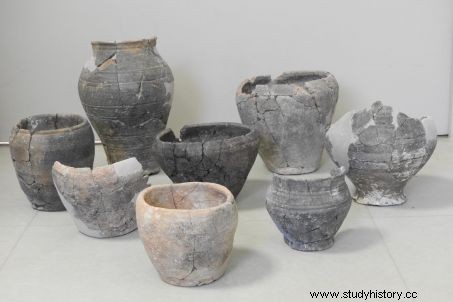Well-preserved Gallic children's graves were recently unearthed in Jort, in Calvados.

Burial of a Gallic child discovered in Jort, (Calvados) in an Iron Age necropolis.
These are small bones of children over 2000 years old that recently appeared under the trowel of archaeologist Vincent Carpentier and a team from the National Institute for Preventive Archaeological Research (Inrap). This astonishing Gallic necropolis was unearthed a few kilometers from the old fortified town of Falaise, in the town of Jort (Calvados). "This city is known to have been an important Gallo-Roman city, but we are establishing that its Gallic past, which predates Caesar's conquest by two or three centuries, was just as considerable “says Vincent Carpentier. Thus, of this children's cemetery, discovered intact, while the ancient remains, with which the region is richly endowed, have often been victims of looting since the 18th century.
Clearance of Gallic child burial. Credit:Inrap
The small graves were dug in limestone, a substrate which explains the very good preservation of the bone remains, including those, fragile, of newborns. The few hundred m 2 of surface studied - on which will soon be built individual houses - correspond to only a small part of the necropolis. Archaeologists have already been able to identify nearly 130 frail remains buried around 70 BC. Not without emotion. “Some of them wore bronze brooches, pearls, or fine lignite bracelets shaped to their proportions ". These funerary ornaments confirm the trade between Gaul and England, the only place at the time from which this fossil raw material was exported.
Lignite bracelet discovered on the wrist of a young deceased from the Gallic cemetery of Jort (Calvados). Credit:Inrap
The discovery of an Iron Age children's necropolis is a rare event. Only about ten have been uncovered throughout France. “The Gauls used to cremate or bury children who had not reached puberty in cemeteries located away from those of adults , says the specialist. This practice had to fit in a religious and cosmological framework, but there must also have been beliefs that immature children might not be considered "completed" individuals. ". Behaviors that continued in the Christianized world of the Middle Ages, when children who died before they could be baptized were to be buried separately.
Placed near some young bodies, pottery may have contained food remains. Credits:Inrap
The skeletons found being those of children whose ages range from birth to eleven years, the specialists now have an exceptional sample to analyze. The first observations have already revealed excess infant mortality after birth, in proportions identical to those known up to the 17th century. This work should be enriched by data from another necropolis of Gallic children still under study, this time in the region of Cherbourg, on a former port agglomeration located in Urville-Nacqueville. These sites testify to the demographic and economic importance of these regions of northwestern France during the second Iron Age (450-50 BC), and the possible interactions existing between clans then residing in Gaul and England.


